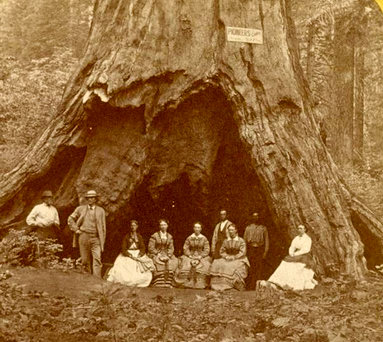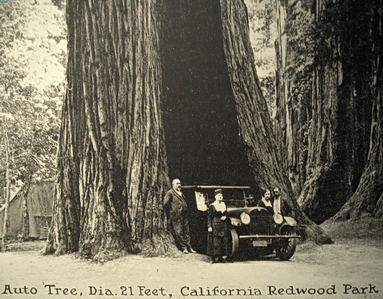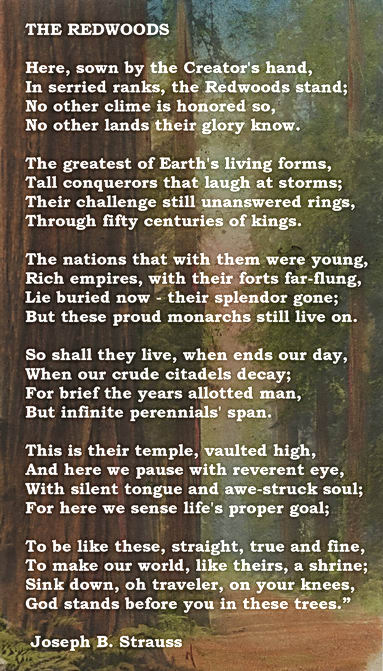| |
|
|
|
|
| |
Big Trees: Pictures & Politics |
|
|
|
| |
|
|
|
|
| |
From Sacred Symbol to Industrial Stumpage |
|
Big Trees as Recreation |
|
| |
Big Trees as Natural Monuments |
|
Big Trees as Curiosities |
|
| |
Big Trees as Cathedrals of Nature |
|
Big Trees as Commercial Products |
|
| |
Big Trees as Trophies |
|
On the Wrong Side of Environmental History |
|
| |
Big Trees as Objects of Science |
|
Greenwashing Weyerhaeuser |
|
| |
|
|
|
|
| |
|
|
| |
|
|
|
|
| |
Big Trees as Recreation
California's native big tree species, the giant Sequoia (Sequoiadendron giganteum) and coastal redwood (Sequoia sempervirens), have been popular tourist attractions ever since the mid 19th century when Europeans first discovered them. Galen Clark wrote in 1907: "There now seems to be no good reason why these Big Trees in California should become extinct for many centuries yet to come, if properly guarded and protected from the ruthless axes and saws of lumbermen. Californians as a mass have not yet fully realized the great value to the State of this magnificent endowment of Nature, one of her most precious crown jewels, which aids in attracting thousands of visitors and millions of dollars annually." One famous attraction is the Auto Tree in the Big Basin Redwood State Park (right). |
|

"Big Basin Redwood State Park"
Old postcard, 1950 |
|
| |
|
|
 |
|
| |

"The Stump and Trunk of the Mammoth Tree"
Lithograph, 1862 |
|
Among the most celebrated of the Sequoias was the Mammoth Tree of Calaveras County. The tree was chopped down in 1857 and the remains were converted into a tourist attraction. Some of the earliest descriptions and illustrations of the natural wonders of California featured the Mammoth Tree. An example is the anonymous folio sized colour lithograph published by James M. Hutchings in 1862 (left). The festive scene shows 32 persons dancing on the Mammoth Tree stump while others are climbing a ladder to the top of the trunk. A detailed wood engraving (below) of the Mammoth Tree's stump, possibly from an early daguerreotype, also appears in a popular book published by Hutchings in 1862 which went through many editions: "Scenes of Wonder. " |
|
| |
|
|
|
|
| |

"A Cotillion Party of Thirty Two Persons Dancing on the Stump of the Mammoth Tree." Wood Engraving
J. M. Hutchings: Scenes of Wonder and Curiosity in California, 1862 |
|
| |
|
|
 |
|
| |

"Mammoth Grove Hotel." Engraving, 1865
Bancroft Library
Hutchings wrote that the Mammoth Grove evoked feelings of sublimity: "The giant trees in silent majesty, Like pillars stand 'neath Heaven's mighty dome.' Would seem that, perched upon their topmost branch, With outstretched finger, man might touch the stars." At the same time, recreation at the grove promoted by Hutchings included the "Double Bowling Alley" (right), built on the prostrate trunk of the Mammoth Tree which was 302 ft long, 96 ft in diameter. |
|
Miner Augustus T. Dowd claimed to have been the first to stumble across the giant Sequoias in the Mammoth Grove in 1852. His discovery brought the unbelievably large species to world attention. Seeking to exploit the big trees as a tourist attraction, in 1861 J. L. Sperry built the Mammoth Grove Hotel. An engraving (left) shows the famed two "Sentinel" trees that frame the forest hotel. The hotel lease was later taken over by James M. Hutchings, who described the Mammoth Grove as "so densely timbered that many hundreds of trees had to be cut down to let in a little sunlight."

"Double Bowling Alley." Engraving
J. M. Hutchings: Scenes of Wonder, 1862 |
|
| |
|
|
 |
|
| |

"Among the Red Woods." Lithograph, c. 1865
Tulare County, California (click to enlarge)
Exeter in Tulare County was founded in 1888 as a frontier town. Today the city is about a 30 minute drive from the entrance to the Sequoia and Kings Canyon National Parks. In 2002 the artist Jeff Crozier painted an illusionistic mural in Exeter entitled "Passport to Paradise" (right). It represents an architectural monument consisting of two linked Sequoia trees that once spanned Highway 65 to welcome visitors to Exeter, the "Gateway to Sequoia National Park." |
|
Recreation among the giant Sequoias in the Sierra Nevadas was also early on promoted along the stage road in Tulare County. The c. 1864 lithograph entitled "Among the Red Woods" (left) advertises J. J. Doyle's "picturesque summer resort," located at an altitude of 7000 feet with "hunting and trout fishing in abundance" as well as "good stage roads and accomodations."

Mural by Jeff Crozier, 2002
Exeter, Tulare County, California |
|
| |
|
|
 |
|
| |

Dead Giant, Tuolumne Grove, California
Old postcard, c. 1880
The "Dead Giant" (above and right) is a famous Sequoia stump located on the first stage road into Yosemite Valley, in the Tuolumne Grove of what is now Yosemite National Park. The veteran Sequoia tree had been struck by lightening but was still living when she was cut down at 90 ft from the ground and debarked. Tunnelled c. 1875 to entice stagecoach tourists from San Francisco, this was the first of California's "Drive Thru" trees – macabre roadside displays created to provide entertainment and recreation. |
|

Dead Giant, Tuolumne Grove, 2007
Yosemite National Park |
|
| |
|
|
 |
|
| |
 |
"And I’ve been
to the groves of
Sequoia Big Trees,
Where beauty and grandeur combine,
Grand Temples of Nature
for worship and ease,
Enchanting, inspiring,
sublime!"
Big Trees of California, 1907 by Galen Clark
|
The Dead Giant's success as a tourist attraction inspired other entrepreneurs to create similar attractions. In 1881 an ancient Sequoia tree in the Mariposa Grove, at the southern approach to Yosemite Valley, was chosen for tunnelling. The tree was 260 ft tall with a 28 ft base and about 2000 years old. "Wawona," as the veteran big tree was called, became Yosemite's most popular tourist attraction (right). Over the years Wawona was pictured on thousands of tourist postcards. Above she appears on the cover of the book by Galen Clark: Big Trees of California (1907). But the brutal assault on her heartwood left Wawona weakened and she finally collapsed during a snow storm in the winter of 1968 – 1969. The demise of the beloved tree icon was said to have revitalized efforts to protect the grand Sequoia forests. |
|

Wawona Tree, Mariposa Grove
Old postcard |
|
| |
|
|
 |
|
| |

Pioneers Cabin Tree, Calaveras Grove, c. 1875
Photo: Lawrence & Houseworth |
|

Pioneers Cabin Tree, Calaveras Grove, 2006
Photo: Gary Voet |
|
| |
|
|
 |
|
| |
To stimulate tourism to the Calaveras Big Tree Grove, another big tree was tunnelled in the 1880s. Known as "Pioneers Cabin Tree," the ancient Sequoia veteran was a popular picnic destination. A c. 1875 photo (above) shows her wide 32 ft in diameter base prior to the violation. A recent photo (above right) shows that the grand tree never recovered. In 1897 another Sequoia, named "Hercules," had a room with a door chopped into her as a tourist attraction and miraculously she survives today (right), in the Mountain Home Demonstration State Forest. As recreation in the Sierra Nevadas increased, the marketing of novelty big trees by competing tourism operators became widespread.

Van Doorman Stump, Porterville, 1900
Photo: San Joaquin Valley Museum |
|

"Hercules." Balch Park, 2007
Mt. Home Demonstration State Forest
Often the stumps of Sequoias were exhibited at expositions as popular attractions. A 1900 photo shows 11 members of the Porterville City Band performing on the "Van Doorman Stump" which was displayed on the main street of the frontier town (left). An archival note states that the stump had earlier been sent to the World's Fair in Paris for display but because it had been cut into pieces for transport, it was discounted as a fake. |
|
| |
|
|
|
|
| |

"The Giant," Santa Cruz County, 1908
Old postcard
By the turn of the century, the native redwood forests of Santa Cruz County were being logged to extermination to supply building materials for the exploding population. San Jose based artist and photographer Andrew P. Hill founded the Sempervirens Club to protect the surviving big trees from the lumber industry. Members of the club posed in 1901 with the remarkable Father of the Forest Tree (right).

"Auto Tree," California Redwood Park, c. 1902
Photo: Bancroft Library |
|
On the California coast, the giant redwood trees (Sequoia sempervirens) also were promoted as novelties and tourist attractions. One big tree grove discovered on the San Lorenzo River in Santa Cruz County was saved from logging when it was purchased in 1867 by Joseph Welch for a tourist attraction. By 1900 "Welch's Big Trees Resort" had become a popular stop on the railway from San Jose to the beaches at Santa Cruz and included the Big Tree Station, a hotel, dining hall, cabins and a dance pavilion. One 310 ft tall redwood, known as "The Giant," was covered with messages left by visitors to the grove (left).

Sempervirens Club, 1901
Photo: Sons and Daughters of Pioneers
To save the redwoods from logging, Andrew P. Hill organized the first meeting of conservationists at Stanford University. Success came a few years later in 1902 when legislators purchased Big Basin and founded California Redwood Park. Hill wrote: "These trees, because of their size and antiquity, were among the natural wonders of the world and should be saved for posterity." For the first time, the giant redwoods were valued not only as lumber, but also for the educational qualities that made them worthy of preservation. To increase its popularity, the park included an "Auto Tree" (left). |
|
| |
|
|
|
|
| |
|
|

Redwood postcards from Santa Cruz County
Above: "Big Trees"
Far left: "Animal Tree," 335 feet high, Big Basin
Left: "Giant Burl Tree," Big Basin |
|
| |
|
|
 |
|
| |

"Fallen Giant," Richardson Grove, Redwood Highway
Old postcard |
|

"Restroom," Redwood Highway
Old postcard |
|
| |
|
|
 |
|
| |
Many tourist facilities with attractions such as the "Fallen Giant"(above) and the "Restroom" log (above right), were developed in the redwood forests north of San Francisco, along what is known as the "Redwood Highway" in Humboldt County, part of US Route 101. Running parallel to the most scenic part of the highway is a 32 mile long road with towering redwoods called the "Avenue of the Giants."

"Lane's Redwood Flat on Redwood Highway"
Old postcard |
|

"Redwood Highway," California
Old postcard
Lane's Redwood Flat (left) was a camping place for tourists located in an ancient grove on the Redwood Highway, now protected as the Smithe Redwood Preserve, part of the California State Park system. Lane's was opened c. 1920 by George W. Lane, a member of the crew that built the Redwood Highway. It operated for over 40 years as a tourist resort and was a main bus stop for tour companies. In the early 1960s, Lane's was purchased by the Save – the – Redwoods – League and deeded to the State of California. |
|
| |
|
|
 |
|
| |

"The Redwoods"
Poem by Joseph B. Strauss |
|
"The Redwoods" (left) is one of the best known tributes to the native forests of California, and emphasizes the religious inspiration derived from the ancient groves. Ironically it was written not by a poet but by Joseph Baermann Strauss, the chief engineer of San Francisco's famed Golden Gate Bridge. Many early postcards of the Redwood Highway and the Avenue of the Giants quoted the verses by Strauss. Today the last two verses from the poem are displayed at the Cathedral Tree in the Trees of Mystery Park at Klamath in northern Humboldt County (below). Cathedral Tree has become a popular arboreal attraction with a pulpit where weddings are often performed.

"Cathedral Tree," Klamath, 2007
Photo: anon |
|
| |
|
|
 |
|
| |

Above: Advertisement
for Redwood Creek wine, 2008 |
Right: Postcard, c. 1950
Below: Poster for 1939 movie "The Big Trees"
 |

|
R - A Redwood Forest
E – Chandelier Tree
D – The Tree House
W – The Del Norte Wonder Tree
O – Redwood Highway
O – Founders Tree
D – Redwood Burl
S – The Shrine Tree |
|

Above: Postcard, "California's Big Trees,"c. 1950. Big tree touring by automobile was widely promoted in California's state parks. |
Right: Ad for Big Tree California Wines. The illustration is based on a c. 1902 photo of US Calvalry F Troop in front of the Grizzly Giant, a famous big tree in the Mariposa Grove of Yosemite. |
 |
|
|
| |
|
|
|
|
| |

"Entrance Log to Trees of Mystery Park"
Old postcard, c. 1930 |
|
|
I think that I shall never see
A poem lovely as a tree.
A tree whose hungry mouth is prest
Against the earth's sweet flowing breast;
A tree that looks at God all day,
And lifts her leafy arms to pray |
At Klamath, the Trees of Mystery Park greets visitors today with background music that features the words of the famous poem "Trees," written in 1913 by Joyce Kilmer (above). One old postcard depicts the original entrance of the park (right), which was through a tunnel in a huge redwood log that had toppled, leaving its shallow root mass upright. Next to the prostrate redwood, axe in hand, stands an eyecatching 49 ft high sculpture of the Midwest lumberjack hero Paul Bunyan. |
|
| |
|
|
|
|
| |

"Shrine Tree," Myers Flat, Redwood Highway, 2008
Photo: Amy Meredith |
|

Avenue of the Giants Map
Photo: Bellaira |
|
| |
|
|
 |
|
| |

Drive On Log, Myers Flat, Redwood Highway, 2007
Photo: Shayanne
Also at Myers Flat is the "Drive On Log" (above and right). Signage says that the tree was cut in 1900 at 3,200 years old. Marked dates on the cross section include: 1) Declaration of Independence; 2) Discovery of America; 3) Magna Carta Signed; 4) First Crusade; 5) Charlemagne Crowned; 6) Christ Born; 7) This Tree Started. |
|
The Shrine Tree at Myers Flat (above left) is one of the best known redwood attractions on the Avenue of the Giants (above). A sign informs visitors that while "3/4 of the wood is dead, 1/4 of the tree refuses to die. The limbs on the tree are evidence of the still living material within. Higher up a double top reaches toward the sky. The tree itself continues to grow and produce cones. It is a good example of the hardy redwood species."

Drive On Log, Myers Flat, 2006.
Photo: R. Nair |
|
| |
|
|
 |
|
| |
|
Picture Gallery of Drive — Through Trees |
 |
 |
 |
Big Cedar Stump
Snohomish County, Wa |
Tunnel Log
Sequoia National Park, Ca |
Dead Giant Stump
Yosemite National Park, Ca |
 |
 |
 |
Shrine Tree
Myers Flat, Redwood Hyw, Ca |
Big Hollow Tree
Stanley Park, Vancouver, BC |
Twin Drive Thru Tree
Confusion Hill, Redwood Hyw, Ca |
 |
 |
 |
California Tunnel Tree
Yosemite National Park, Ca |
Auto Tree
Big Basin Redwood State Park, Ca |
Bicycle Tree
Snohomish County, Wa |
 |
 |
 |
Pioneers Cabin Tree
Calaveras State Park, Ca |
Coolidge Tree
Leggett, Redwood Hyw, Ca |
Tour Thru Tree
Klamath, Redwood Hyw, Ca |
 |
 |
 |
Goose Pen Tree
Lanes Flat, Redwood Hyw, Ca |
Doust Drive Thru Tree
Garberville, Redwood Hyw, Ca |
Drive Way Stump, Pepperwood
Redwood Highway, Ca |
|
|
| |
|
|
 |
|
| |

Chandelier Tree, Underwood Park, 2007
Leggett, Redwood Highway |
|

Chandelier Tree. Sign, 2007
Leggett, Redwood Highway |
|
| |
|
|
 |
|
| |
|
|
| |
©
Credits & Contact |
|
| |
|
|
|
|

